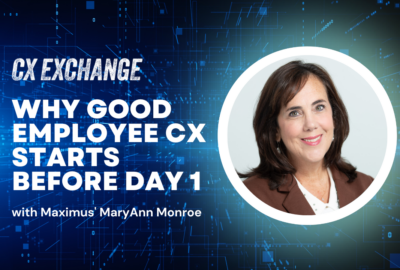Insight by Maximus
CX Exchange 2024: Maximus’ MaryAnn Monroe on tech advances in experience capabilities
Agencies need to apply artificial intelligence and other technologies to improve services in real time based on citizen needs, Maximus’ experience leader says.
When it comes to understanding their customer experience data, agencies are dipping into the cybersecurity lexicon.
More and more organizations want to view customer, employee, structured and unstructured data through a “single pane of glass,” a term typically reserved for pulling together data from a variety of cybersecurity tools.
And like in the cyber world, agencies are starting to see the need to view this total experience through an integrated platform that brings together a variety of data sources.
“For our customers, we want them to have a simple, seamless and secure experience when interacting with a digital service as well as a human-based service,” said MaryAnn Monroe, vice president of total experience solutions and services at Maximus, during the Federal News Network’s 2024 CX Exchange.
“That’s really critical because that really taps into our employee experience — and the tools that we provide at their fingertips as well as our managers and supervisors — to be able to have that view of the operation and also the customer and employee experience in one single place.”
Making sense of data in real time
The spillover of cybersecurity concepts into CX isn’t surprising. Agencies are facing similar challenges and opportunities in both realms given the amount of data they are collecting, the need to understand what’s happening in real time and the impact on the mission.
Monroe said the agencies Maximus work with are looking for the “pulse of the public” and for very specific insights from the public around different topics.
“Having that data at our fingertips and being able to use that and inform the agencies that we work with is very critical because it also helps inform decisions. It also tells us where pivots may need to be made or information needs to be developed — trying to bridge the gap in many cases where information doesn’t exist or maybe doesn’t exist as clearly as it needs to be based on what the public is telling us,” she said.
“We see that across agencies that are really trying to get that information much more clearly and not have to look in 10, 12, 15 different systems to cobble that together to understand the story. We’re getting better and better with our technology platforms and being able to pull that together to be able to tell that story from a single pane of glass.”
Taking advantage of AI, other advancing technologies for CX
Of course to deal with all the data, both structured and unstructured, agencies also are starting to turn to artificial intelligence and advanced data analytics. Agencies can apply these tools to improve operations as well as improve the employee experience.
“In several of our large programs supporting agencies, we’re able to pull in more unstructured customer and employee data about our actions or words spoken or customer intent. These are things that they care about and things that they’re asking about,” Monroe said. “We’re able to leverage AI to pull that information in so that we can actually understand the pulse of the public a little bit better, so that we can tell a better story or see what those impacts are in the program that we need to elevate to our agency stakeholders.”
She added several Maximus programs use AI, such as agent assist, to understand the topics citizens are asking and then bring back particular information that employees can use to answer questions more quickly.
“Those days where employees had to flip through a gazillion different pages of information, whether it’s digital or in a notebook, are over. We’ve certainly come a long way. AI is enabling very specific topics to be served right up to the desktop for them to click on and use as a resource to answer questions,” Monroe said.
Not only does this approach help make the employee experience more efficient, but it also allows integration of other forms of omnichannel communication into the interactions, she said.
“For example, if somebody has called for a particular piece of information, health information, for example, we’re able to integrate and say, ‘Would you like us to text that information to you or email it?’ Many times we can text it right to the customer while they’re still on the line and check to see that they’ve received it,” Monroe said.
Not all technology needs to be cutting edge. Many agencies also are turning to more straightforward automation tools like robotic process automation to improve the efficiency of services.
Monroe said no matter the tools agencies use, transparency and security are paramount to create long-standing trust. She warned that AI and similar tools, if not used correctly, could erode trust in the service or organization.
That’s why Monroe recommended agencies start small, with pilots, before expanding use of AI and other CX tools.
“We are all in with improving digital experiences where it makes sense and where people need those services,” she said. “The fact is that we need to understand who we’re serving and be able to provide those services. In many agencies, in-person services are still vitally important — at Social Security, the IRS, the Agriculture Department, the Department of Veterans Affairs. Those are very important services that the American public relies on and definitely have to factor into this equation of how we strike that balance with technology.”
Discover more customer experience tactics and takeaways from Federal News Network’s CX Exchange 2024 now.
Copyright © 2025 Federal News Network. All rights reserved. This website is not intended for users located within the European Economic Area.
Jason Miller is executive editor of Federal News Network and directs news coverage on the people, policy and programs of the federal government.
Follow @jmillerWFED





